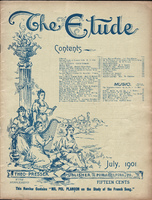R. A.—In playing a finger-exercise or scale the fifth finger should be raised, using the first joint only; so that the tip of the finger is immediately above the center of the key, the second and third joints preserving the proper curve of the finger as it falls upon the key. The fifth finger should not be raised higher than the others nor allowed to straighten. Practicing the raising and dropping of all the fingers upon a table will be found beneficial and corrective of bad habits of position and action.
J. C. W.—If you will read carefully and follow out the directions given in “Touch and Technic” you will discover that the criticism, which claims that so much relaxation leads to weakness, is not well founded. The idea is that muscular contraction should take place only in the actual instant of attacking the key, the relaxed conditions immediately preceding and following this action. Of course, this principle, like everything else, may be overdone.
H. E. E.—1. Double thirds are thirds played simultaneously in either hand. You will find the scales written in this manner (also in fourths and sixths) and correctly fingered in Loeschhorn’s “Technics” and similar volumes.
2. In indicating the “glissando” or “slide,” of the second finger, it is necessary to write the figure 2 but once over the first note of the passage, writing above the passage the abbreviation “gliss.” In the descending passage the first finger (1) may be indicated in a similar manner.
3. Transposing is writing or playing in any key a composition written in some other key; for instance, a piece written in the key of F if transposed one tone higher, would be written or played in the key of G, each note of the melody and accompaniment being played one whole tone higher than in the original.
M. E. K.—The terms “International” and “Standard,” as applied to tuning, refer to the standard of pitch. The “International,” which is generally considered as the “Standard,” is based on 435 vibrations to A, second space, treble clef, and is the one most generally used. It is also called, sometimes, “French” pitch. The formerly used “Concert” pitch was much higher, but is practically abandoned, save in a few makes of the cheaper grade of pianos, and in most band instruments.
H.—1. For a description of Gottschalk’s “Last Hope” see the edition published by Theodore Presser. It was edited by a pupil of the composer, and is authoritative.
2. A short straight line over a note signifies non-legato or pressure touch. The note should have nearly its full value. It is the weakest form of an accented note.
N. B. G.—1. You will find “First Steps in Piano- Forte Study” the best work in elementary instruction, and thoroughly equal to present-day demands.
2. You will find the various arpeggios given in all good books of instruction and of technic, or you can secure a separate copy of them in sheet music form from the publisher of The Etude. They should first be taught simply within the compass of an octave, and then gradually extended. It is not necessary to wait until all the scales are learned before taking up the arpeggios; in fact, it is better not to do so. The arpeggios should, of course, be studied in all keys, major and minor, the common chords first, then the various chords of the seventh.
3. In making the great barré on the guitar the point of the finger should be toward the performer, the hand being slightly turned toward the guitar.
4. It is not customary to repeat the various sections inclosed between repeat-marks upon making a D. C.
5. According to a majority of the best authorities, a boy whose voice is passing through the period of mutation should not sing under any circumstances.
M. E. B.—You are right in thinking music unpleasant for both teacher and pupil when it is nothing but grind and drudgery. Many a promising pupil has been spoiled and lost to music by just such dry and mechanical treatment as you describe. You seem to be on the right track at present and should do your best to keep the interest of your pupil, using for the present at least what is melodious and pleasing; such, for instance, as may be found in the “Sonatina Album.” The cause of the hard, unsympathetic touch may lie in improper physical conditions—too much rigidity, little or no relaxation. Too much attention cannot be paid to this important particular.



